Budgeted Thompson Sampling for IRS Enabled WiGig Relaying
Abstract
:1. Introduction
- The WiGig IRS relay probing problem is mathematically formulated as an optimization problem in order to choose the supreme IRS relay that maximizes the attainable data rates of WiGig communication linkages. Still, the selection process is constrained by the time consumption of the BT procedure of the chosen IRS panel;
- WiGig-IRS relay probing issue is reformulated as online budgeted MAB, where budgeted Thompson sampling (BTS-IRS) with guaranteed time-cost performance is envisioned to handle it. Herein, the WGBS, IRS boards/relays, throughput, and BT are the bandit player, arms, reward, and cost, respectively;
- The proposed BTS-IRS algorithm demonstrates superior performance compared to other benchmark schemes through numerous numerical simulations in various scenarios as the BT processing time is amended to the classical TS formula as a budget/cost;
- Numerous numerical evaluations were carried out to illustrate the superiority of the envisioned BTS scheme compared to other benchmarks such as the brute force solution, the classical TS algorithm [16,17], and random selection of IRS relays. Moreover, BTS-IRS is compared to previous cost-effective UCB-based MAB schemes. The BTS-IRS scheme exhibited an average spectral efficiency that was superior to other benchmark schemes, with comparable BT time computation.
2. Related Works
3. System Model and Problem Statement
4. Envisioned BTS-IRS Algorithm
4.1. MAB Concept
4.2. Envisioned BTS Algorithm
| Algorithm 1: Proposed BTS-IRS Algorithm |
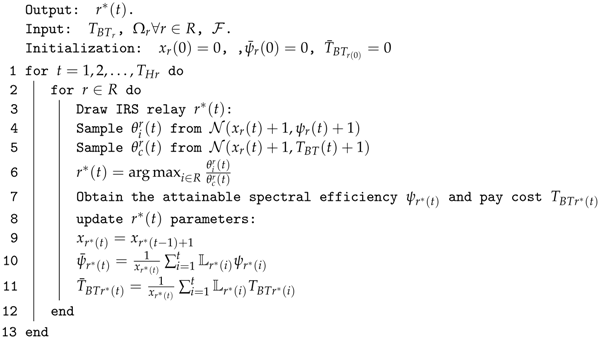 |
5. Numerical Analysis
5.1. Performance versus Different Numbers of IRS Relays
5.2. Performance versus Different Values of Transmitter Power
5.3. Complexity Analysis
6. Conclusions
Author Contributions
Funding
Data Availability Statement
Acknowledgments
Conflicts of Interest
References
- Uwaechia, A.N.; Mahyuddin, N.M. A Comprehensive Survey on Millimeter Wave Communications for Fifth-Generation Wireless Networks: Feasibility and Challenges. IEEE Access 2020, 8, 62367–62414. [Google Scholar] [CrossRef]
- Hong, W.; Jiang, Z.H.; Yu, C.; Hou, D.; Wang, H.; Guo, C.; Hu, Y.; Kuai, L.; Yu, Y.; Jiang, Z.; et al. The Role of Millimeter-Wave Technologies in 5G/6G Wireless Communications. IEEE J. Microw. 2021, 1, 101–122. [Google Scholar] [CrossRef]
- Liu, Y.; Liu, X.; Mu, X.; Hou, T.; Xu, J.; Di Renzo, M.; Al-Dhahir, N. Reconfigurable Intelligent Surfaces: Principles and Opportunities. IEEE Commun. Surv. Tutor. 2021, 23, 1546–1577. [Google Scholar] [CrossRef]
- Sejan, M.A.S.; Rahman, M.H.; Shin, B.-S.; Oh, J.-H.; You, Y.-H.; Song, H.-K. Machine Learning for Intelligent-Reflecting-Surface-Based Wireless Communication towards 6G: A Review. Sensors 2022, 22, 5405. [Google Scholar] [CrossRef] [PubMed]
- Björnson, E.; Özdogan, Ö.; Larsson, E.G. Intelligent Reflecting Surface Versus Decode-and-Forward: How Large Surfaces are Needed to Beat Relaying? IEEE Wirel. Commun. Lett. 2020, 9, 244–248. [Google Scholar] [CrossRef] [Green Version]
- Almohamad, A.; Hasna, M.; Zorba, N.; Khattab, T. Performance of THz Communications Over Cascaded RISs: A Practical Solution to the Over-Determined Formulation. IEEE Commun. Lett. 2022, 26, 291–295. [Google Scholar] [CrossRef]
- Hashima, S.; Hatano, K.; Mohamed, E.M. Advanced MAB Schemes for WiGig-Aided Aerial Mounted RIS Wireless Networks. In Proceedings of the IEEE Consumer Communications & Networking Conference, Lasvegas, NV, USA, 8–11 January 2023. [Google Scholar]
- Chen, Y.; Wang, Y.; Jiao, L. Robust Transmission for Reconfigurable Intelligent Surface Aided Millimeter Wave Vehicular Communications With Statistical CSI. IEEE Trans. Wirel. Commun. 2022, 21, 928–944. [Google Scholar] [CrossRef]
- Luo, R.; Ni, W.; Tian, H.; Cheng, J. Federated Deep Reinforcement Learning for RIS-Assisted Indoor Multi-Robot Communication Systems. IEEE Trans. Veh. Technol. 2022, 71, 12321–12326. [Google Scholar] [CrossRef]
- Schroeder, R.; He, J.; Brante, G.; Juntti, M. Two-Stage Channel Estimation for Hybrid RIS Assisted MIMO Systems. IEEE Trans. Commun. 2022, 70, 4793–4806. [Google Scholar] [CrossRef]
- He, J.; Wymeersch, H.; Juntti, M. Channel Estimation for RIS-Aided mmWave MIMO Systems via Atomic Norm Minimization. IEEE Trans. Wirel. Commun. 2021, 20, 5786–5797. [Google Scholar] [CrossRef]
- Yang, F.; Wang, J.-B.; Zhang, H.; Lin, M.; Cheng, J. Multi-IRS-Assisted mmWave MIMO Communication Using Twin-Timescale Channel State Information. IEEE Trans. Commun. 2022, 70, 6370–6384. [Google Scholar] [CrossRef]
- Nguyen, T.V.; Truong, T.P.; Nguyen, T.M.T.; Noh, W.; Cho, S. Achievable Rate Analysis of Two-Hop Interference Channel with Coordinated IRS Relay. IEEE Trans. Wirel. Commun. 2022, 21, 7055–7071. [Google Scholar] [CrossRef]
- Yuan, Y.; Wu, D.; Huang, Y.; Chih-Lin, I. Reconfigurable Intelligent Surface Relay: Lessons of the Past and Strategies for Its Success. IEEE Commun. Mag. 2022, 60, 117–123. [Google Scholar] [CrossRef]
- Xia, Y.; Qin, T.; Weidong, M.; Nenghai, Y.; Liu, T. Budgeted Multi-Armed Bandits with Multiple Plays. In Proceedings of the 25th International Joint Conference on Artificial Intelligence IJCAI, New York, NY, USA, 9–15 July 2016. [Google Scholar]
- Agrawal, S.; Goyal, N. Analysis of Thompson Sampling for the Multi-armed Bandit Problem. In Proceedings of the 25th Annual Conference on Learning Theory, Edinburgh, UK, 25–27 June 2012. [Google Scholar]
- Audibert, J.; Munos, R.; Szepesvari, C. Exploration-exploitation tradeoff using variance estimates in multi-armed bandits. Theor. Comput. Sci. 2009, 410, 1876–1902. [Google Scholar] [CrossRef]
- Lin, Z.; Niu, H.; An, K.; Wang, Y.; Zheng, G.; Chatzinotas, S.; Hu, Y. Refracting RIS-Aided Hybrid Satellite-Terrestrial Relay Networks: Joint Beamforming Design and Optimization. IEEE Trans. Aerosp. Electron. Syst. 2022, 58, 3717–3724. [Google Scholar] [CrossRef]
- Lin, Z.; An, K.; Niu, H.; Hu, Y.; Chatzinotas, S.; Zheng, G.; Wang, J. SLNR-based Secure Energy Efficient Beamforming in Multibeam Satellite Systems. IEEE Trans. Aerosp. Electron. Syst. 2022. early access. [Google Scholar] [CrossRef]
- Lin, Z.; Lin, M.; Wang, J.-B.; de Cola, T.; Wang, J. Joint Beamforming and Power Allocation for Satellite-Terrestrial Integrated Networks with Non-Orthogonal Multiple Access. IEEE J. Sel. Top. Signal Process. 2019, 13, 657–670. [Google Scholar] [CrossRef] [Green Version]
- Niu, H.; Lin, Z.; Chu, Z.; Zhu, Z.; Xiao, P.; Nguyen, H.X.; Lee, I.; Al-Dhahir, N. Joint Beamforming Design for Secure RIS-Assisted IoT Networks. IEEE Internet Things J. 2023, 10, 1628–1641. [Google Scholar] [CrossRef]
- Pei, X.; Yin, H.; Tan, L.; Cao, L.; Li, Z.; Wang, K.; Zhang, K.; Bjornson, E. RIS-Aided Wireless Communications: Prototyping, Adaptive Beamforming, and Indoor/Outdoor Field Trials. IEEE Trans. Commun. 2021, 69, 8627–8640. [Google Scholar] [CrossRef]
- Tang, W.; Chen, M.Z.; Dai, J.Y.; Zeng, Y.; Zhao, X.; Jin, S.; Cheng, Q.; Cui, T.J. Wireless Communications with Programmable Metasurface: New Paradigms, Opportunities, and Challenges on Transceiver Design. IEEE Wirel. Commun. 2020, 27, 180–187. [Google Scholar] [CrossRef] [Green Version]
- Cheng, Q.; Li, L.; Zhao, M.-M.; Zhao, M.-J. Cooperative Localization for Reconfigurable Intelligent Surface-Aided mmWave Systems. In Proceedings of the 2022 IEEE Wireless Communications and Networking Conference (WCNC), Austin, TX, USA, 10–13 April 2022; pp. 1051–1056. [Google Scholar] [CrossRef]
- Mohamed, E.M.; Hashima, S.; Anjum, N.; Hatano, K.; Shafai, W.E.; Elhalawany, B.M. Reconfigurable intelligent surface-aided millimeter wave communications utilizing two-phase minimax optimal stochastic strategy bandit. IET Commun. 2022, 16, 2200–2207. [Google Scholar] [CrossRef]
- Taha, A.; Alrabeiah, M.; Alkhateeb, A. Enabling Large Intelligent Surfaces with Compressive Sensing and Deep Learning. IEEE Access 2021, 9, 44304–44321. [Google Scholar] [CrossRef]
- Jia, C.; Gao, H.; Chen, N.; He, Y. Machine learning empowered beam management for intelligent reflecting surface assisted MmWave networks. China Commun. 2020, 17, 100–114. [Google Scholar] [CrossRef]
- Abdullah, Z.; Chen, G.; Lambotharan, S.; Chambers, J.A. A Hybrid Relay and Intelligent Reflecting Surface Network and Its Ergodic Performance Analysis. IEEE Wirel. Commun. Lett. 2020, 9, 1653–1657. [Google Scholar] [CrossRef]
- Torkzaban, N.; Khojastepour, M.A.A. Shaping mmWave Wireless Channel via Multi-Beam Design using Reconfigurable Intelligent Surfaces. In Proceedings of the 2021 IEEE Globecom Workshops (GC Wkshps), Madrid, Spain, 7–11 December 2021; pp. 1–6. [Google Scholar] [CrossRef]
- Zhao, D.; Lu, H.; Wang, Y.; Sun, H. Joint Passive Beamforming and User Association Optimization for IRS-assisted mmWave Systems. In Proceedings of the GLOBECOM 2020—2020 IEEE Global Communications Conference, Taipei, Taiwan, 7–11 December 2020; pp. 1–6. [Google Scholar] [CrossRef]
- Wang, P.; Fang, J.; Zhang, W.; Li, H. Fast Beam Training and Alignment for IRS-Assisted Millimeter Wave/Terahertz Systems. IEEE Trans. Wirel. Commun. 2022, 21, 2710–2724. [Google Scholar] [CrossRef]
- Zhang, Y.; Di, B.; Zhang, H.; Lin, J.; Xu, C.; Zhang, D.; Li, Y.; Song, L. Beyond Cell-Free MIMO: Energy Efficient Reconfigurable Intelligent Surface Aided Cell-Free MIMO Communications. IEEE Trans. Cogn. Commun. Netw. 2021, 7, 412–426. [Google Scholar] [CrossRef]
- Hao, W.; Li, J.; Sun, G.; Zeng, M.; Dobre, O.A. Securing Reconfigurable Intelligent Surface-Aided Cell-Free Networks. IEEE Trans. Inf. Forensics Secur. 2022, 17, 3720–3733. [Google Scholar] [CrossRef]
- Mensi, N.; Rawat, D.B. On the Performance of Partial RIS Selection vs. Partial Relay Selection for Vehicular Communications. IEEE Trans. Veh. Technol. 2022, 71, 9475–9489. [Google Scholar] [CrossRef]
- Mohamed, E.M.; Hashima, S.; Hatano, K.; Fouda, M.M. Cost-Effective MAB Approaches for Reconfigurable Intelligent Surface Aided Millimeter Wave Relaying. IEEE Access 2022, 10, 81642–81653. [Google Scholar] [CrossRef]
- Guo, X.; Chen, Y.; Wang, Y. Learning-Based Robust and Secure Transmission for Reconfigurable Intelligent Surface Aided Millimeter Wave UAV Communications. IEEE Wirel. Commun. Lett. 2021, 10, 1795–1799. [Google Scholar] [CrossRef]
- Francisco-Valencia, I.; Marcial-Romero, J.R.; Valdovinos, R.M. A comparison between UCB and UCB-Tuned as selection policies in GGP. J. Intell. Fuzzy Syst. 2019, 36, 5073–5079. [Google Scholar] [CrossRef]
- Agrawal, S.; Goyal, N. Near-Optimal Regret Bounds for Thompson Sampling. J. ACM 2017, 64, 30. [Google Scholar] [CrossRef]
- Sinha, D.; Sankararama, K.A.; Kazerouni, A.; Avadhanula, V. Multi-armed Bandits with Cost Subsidy. In Proceedings of the 24th International Conference on Artificial Intelligence and Statistics, San Diego, CA, USA, 13–15 April 2021. [Google Scholar]
- Ding, W.; Qin, T.; Zhang, X.; Liu, T. Multi-Armed Bandit with Budget Constraint and Variable Costs. In Proceedings of the AAAI Conference on Artificial Intelligence, Bellevue, WA, USA, 14–18 July 2013. [Google Scholar] [CrossRef]
- Xia, Y.; Li, H.; Qin, T.; Yu, N.; Liu, T. Thompson Sampling for Budgeted Multi-Armed Bandits. In Proceedings of the International Joint Conference on Artificial Intelligence, Buenos Aires, Argentina, 25–31 July 2015. [Google Scholar]
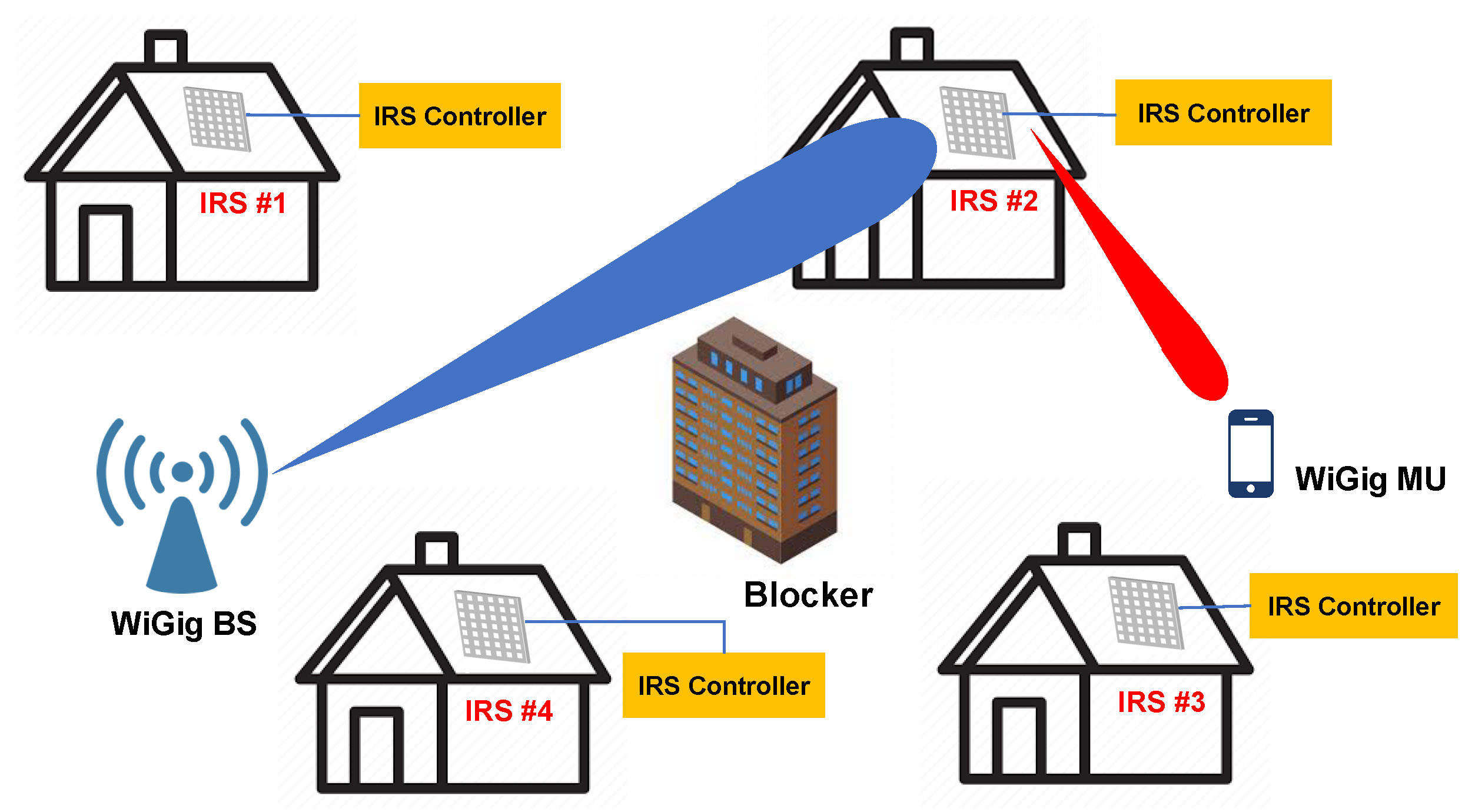
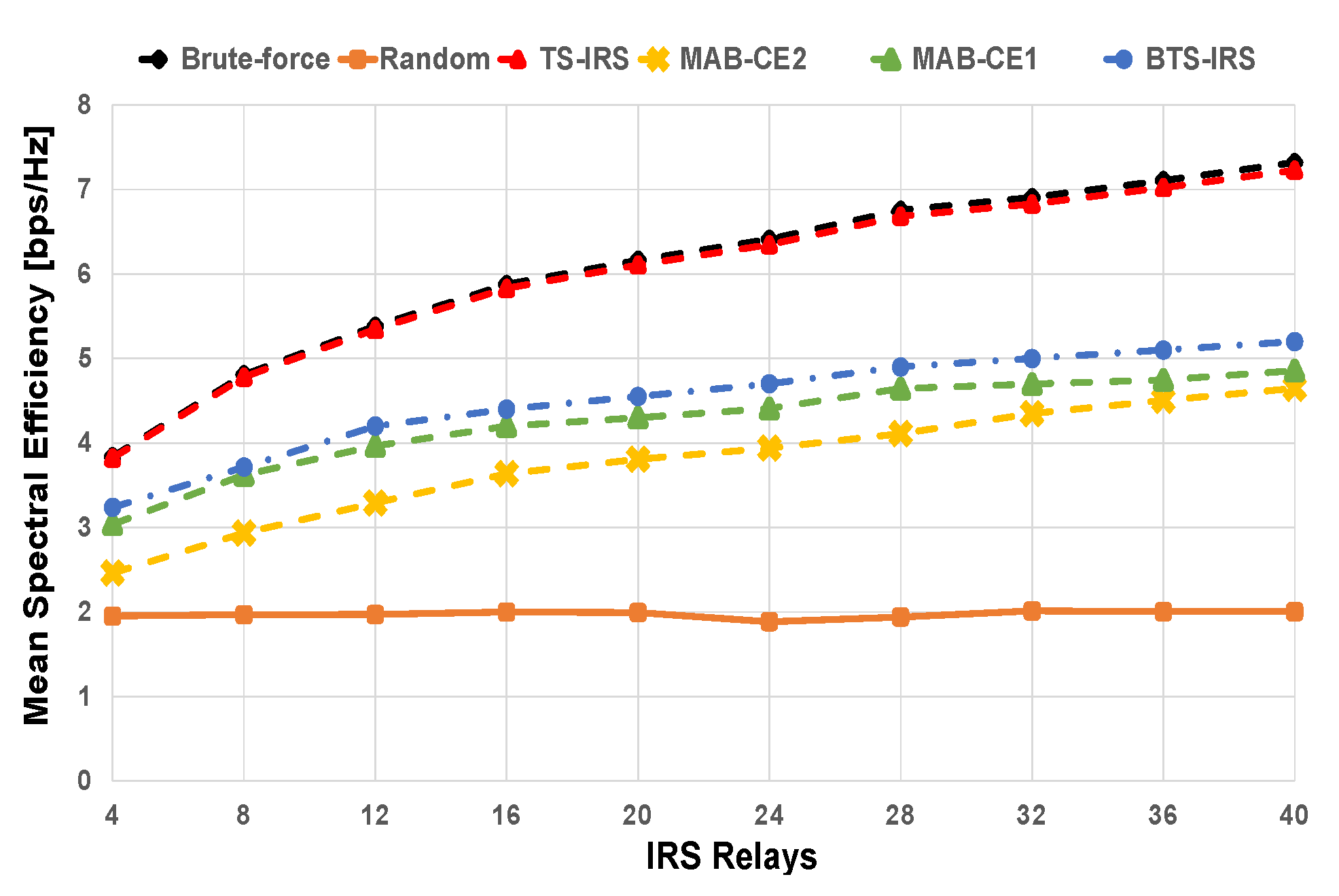

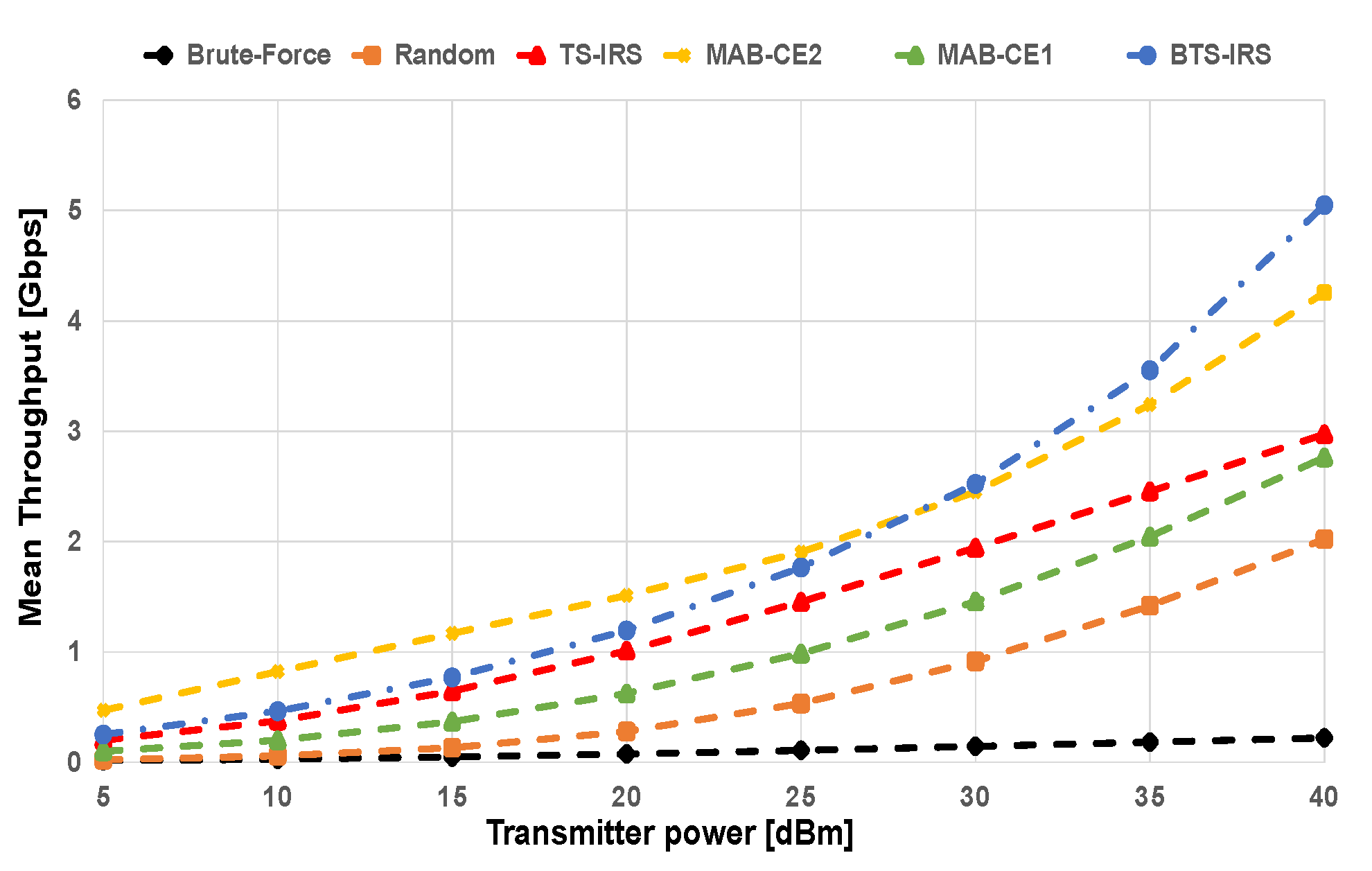
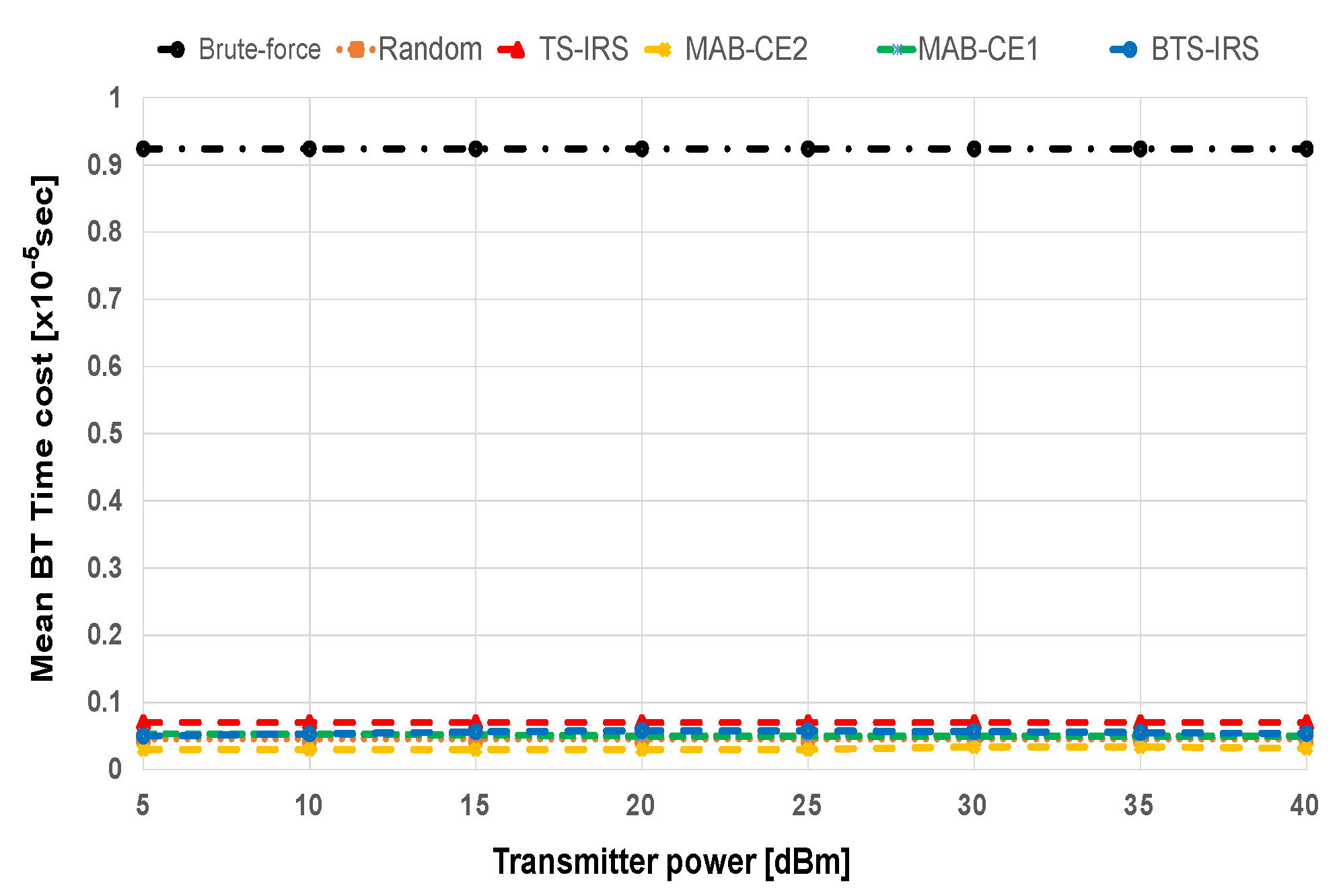
| Parameter | Value |
|---|---|
| 30 dBm | |
| 2.16 GHz | |
| −114 dBm | |
| 5 | |
| 5 | |
| M | 16 |
| 16 | |
| 1000 | |
| 20 ms | |
| 46 s | |
| 61 dB |
Disclaimer/Publisher’s Note: The statements, opinions and data contained in all publications are solely those of the individual author(s) and contributor(s) and not of MDPI and/or the editor(s). MDPI and/or the editor(s) disclaim responsibility for any injury to people or property resulting from any ideas, methods, instructions or products referred to in the content. |
© 2023 by the authors. Licensee MDPI, Basel, Switzerland. This article is an open access article distributed under the terms and conditions of the Creative Commons Attribution (CC BY) license (https://creativecommons.org/licenses/by/4.0/).
Share and Cite
Hashima, S.; Hatano, K.; Takimoto, E.; Mohamed, E.M. Budgeted Thompson Sampling for IRS Enabled WiGig Relaying. Electronics 2023, 12, 1146. https://doi.org/10.3390/electronics12051146
Hashima S, Hatano K, Takimoto E, Mohamed EM. Budgeted Thompson Sampling for IRS Enabled WiGig Relaying. Electronics. 2023; 12(5):1146. https://doi.org/10.3390/electronics12051146
Chicago/Turabian StyleHashima, Sherief, Kohei Hatano, Eiji Takimoto, and Ehab Mahmoud Mohamed. 2023. "Budgeted Thompson Sampling for IRS Enabled WiGig Relaying" Electronics 12, no. 5: 1146. https://doi.org/10.3390/electronics12051146







